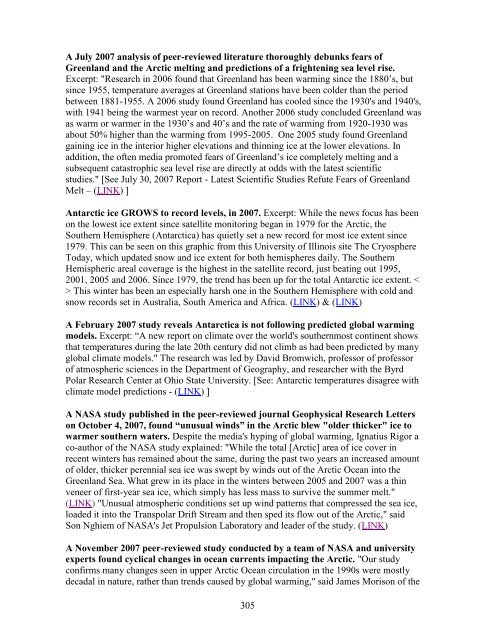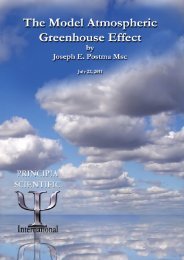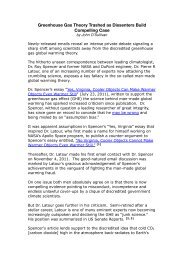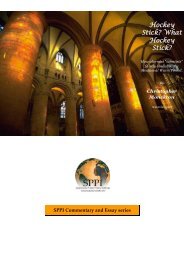Than 1000 International Scientists Dissent Over Man-Made Global ...
Than 1000 International Scientists Dissent Over Man-Made Global ...
Than 1000 International Scientists Dissent Over Man-Made Global ...
You also want an ePaper? Increase the reach of your titles
YUMPU automatically turns print PDFs into web optimized ePapers that Google loves.
A July 2007 analysis of peer-reviewed literature thoroughly debunks fears of<br />
Greenland and the Arctic melting and predictions of a frightening sea level rise.<br />
Excerpt: "Research in 2006 found that Greenland has been warming since the 1880‘s, but<br />
since 1955, temperature averages at Greenland stations have been colder than the period<br />
between 1881-1955. A 2006 study found Greenland has cooled since the 1930's and 1940's,<br />
with 1941 being the warmest year on record. Another 2006 study concluded Greenland was<br />
as warm or warmer in the 1930‘s and 40‘s and the rate of warming from 1920-1930 was<br />
about 50% higher than the warming from 1995-2005. One 2005 study found Greenland<br />
gaining ice in the interior higher elevations and thinning ice at the lower elevations. In<br />
addition, the often media promoted fears of Greenland‘s ice completely melting and a<br />
subsequent catastrophic sea level rise are directly at odds with the latest scientific<br />
studies." [See July 30, 2007 Report - Latest Scientific Studies Refute Fears of Greenland<br />
Melt – (LINK) ]<br />
Antarctic ice GROWS to record levels, in 2007. Excerpt: While the news focus has been<br />
on the lowest ice extent since satellite monitoring began in 1979 for the Arctic, the<br />
Southern Hemisphere (Antarctica) has quietly set a new record for most ice extent since<br />
1979. This can be seen on this graphic from this University of Illinois site The Cryosphere<br />
Today, which updated snow and ice extent for both hemispheres daily. The Southern<br />
Hemispheric areal coverage is the highest in the satellite record, just beating out 1995,<br />
2001, 2005 and 2006. Since 1979, the trend has been up for the total Antarctic ice extent. <<br />
> This winter has been an especially harsh one in the Southern Hemisphere with cold and<br />
snow records set in Australia, South America and Africa. (LINK) & (LINK)<br />
A February 2007 study reveals Antarctica is not following predicted global warming<br />
models. Excerpt: ―A new report on climate over the world's southernmost continent shows<br />
that temperatures during the late 20th century did not climb as had been predicted by many<br />
global climate models." The research was led by David Bromwich, professor of professor<br />
of atmospheric sciences in the Department of Geography, and researcher with the Byrd<br />
Polar Research Center at Ohio State University. [See: Antarctic temperatures disagree with<br />
climate model predictions - (LINK) ]<br />
A NASA study published in the peer-reviewed journal Geophysical Research Letters<br />
on October 4, 2007, found “unusual winds” in the Arctic blew "older thicker" ice to<br />
warmer southern waters. Despite the media's hyping of global warming, Ignatius Rigor a<br />
co-author of the NASA study explained: "While the total [Arctic] area of ice cover in<br />
recent winters has remained about the same, during the past two years an increased amount<br />
of older, thicker perennial sea ice was swept by winds out of the Arctic Ocean into the<br />
Greenland Sea. What grew in its place in the winters between 2005 and 2007 was a thin<br />
veneer of first-year sea ice, which simply has less mass to survive the summer melt."<br />
(LINK) "Unusual atmospheric conditions set up wind patterns that compressed the sea ice,<br />
loaded it into the Transpolar Drift Stream and then sped its flow out of the Arctic," said<br />
Son Nghiem of NASA's Jet Propulsion Laboratory and leader of the study. (LINK)<br />
A November 2007 peer-reviewed study conducted by a team of NASA and university<br />
experts found cyclical changes in ocean currents impacting the Arctic. "Our study<br />
confirms many changes seen in upper Arctic Ocean circulation in the 1990s were mostly<br />
decadal in nature, rather than trends caused by global warming," said James Morison of the<br />
305





